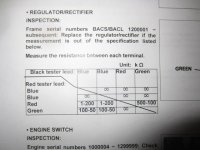I was hoping to use the charging plug on my old 1985 bf100.. When I checked the voltage it was like 5-6 volts, not wide open but certainly above idle... I would expect amperage to drop with rpm but voltage to remain somewhat constant..or am I all wet??
Anyone with a bf100 charging system tell me what voltage they get.. I wanted to charge the battery with the trollling motor and hook up an electric downrigger as most of my time on the water is spent running the kicker but don't want a dead battery when its time to run back to the launch.. As an aside, what happens to a 12v battery when it gets below voltage charging input?
I don't understand the chart on page 4-25 of the shop manual.. It shows units as K ohm.. Range blue to red 1-200, green to blue 100-50.. Usually ranges are expressed consistently,, like low to high.. This reads low to high in one column and high to low in others...?? Seems like a misprint somewhere..

Anyone with a bf100 charging system tell me what voltage they get.. I wanted to charge the battery with the trollling motor and hook up an electric downrigger as most of my time on the water is spent running the kicker but don't want a dead battery when its time to run back to the launch.. As an aside, what happens to a 12v battery when it gets below voltage charging input?
I don't understand the chart on page 4-25 of the shop manual.. It shows units as K ohm.. Range blue to red 1-200, green to blue 100-50.. Usually ranges are expressed consistently,, like low to high.. This reads low to high in one column and high to low in others...?? Seems like a misprint somewhere..

Last edited:

